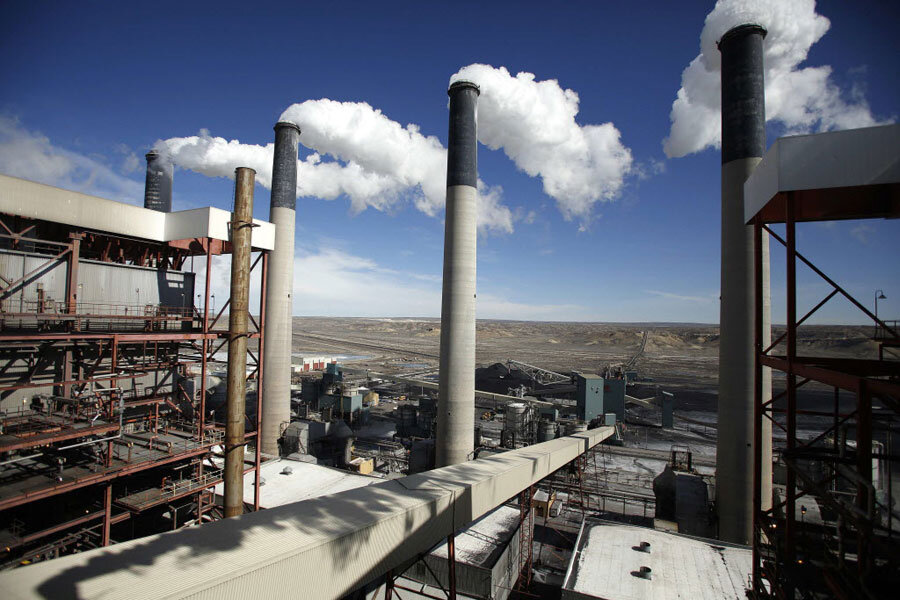How would climate change regulations help now? Study seeks answer.
Loading...
For years, the debate about efforts to find the best way to rein in greenhouse gas emissions has wrestled with a generation gap: The worst effects of climate change are projected to occur in the distant future over a wide area, but the costs to combat it will be very local and immediate.
A study released Monday in the journal Nature Climate Change is one attempt to bridge that gap. The conclusions suggest that efforts to reduce carbon dioxide emissions from coal-fired power plants in the United States could deliver important regional and local public health benefits.
These benefits would come not from reducing CO2 emissions per se, but from simultaneous reductions in other emissions that accompany burning coal, such as sulfur dioxide, nitrogen oxides, mercury, and fine-grained particles.
Indeed, the study found that the most effective approach for meeting CO2 and health concerns is one put forward by the United States Environmental Protection Agency last June – the centerpiece for President Obama's effort to confront global warming.
"The message of our work is that combating climate change produces real benefits in the present and close to home," says Dallas Burtraw, an economist with Resources for the Future, a Washington-based environmental think tank and a co-author of the study, which appears this week in the journal Nature Climate Change.
According to one scenario outlined in the study, as many as 3,500 premature deaths a year could be avoided by 2020, the study indicates. These would come from additional reductions in emissions of mercury, sulfur-dioxide, nitrogen oxides (a precursor to ozone pollution), and fine-grained particulates, which public-health officials say contributes to respiratory problems.
"Areas with the worst air quality get the most co-benefits," says Charles Driscoll, an environmental chemist at Syracuse and the study's lead author. But every state in the lower 48 would see some benefits, he adds.
The American Coalition for Clean Coal Electricity rejected the study as an academic exercise.
"While these academics are hypothesizing about unprovable consequences, what’s known is that families are struggling to pay their monthly bills and companies are struggling to stay in business – and any increase in energy costs will burden them unnecessarily,” said Laura Sheehan, the organization's spokeswoman, in a statement.
But the researchers involved in the new study – from Syracuse University, Harvard University, Boston University, Sonoma Technology, Inc., as well as Resources for the Future – see the "academic" label as a plus. The study represents an independent analysis subject to rigorous peer review, they note.
"It is an academic exercise – a sophisticated and a detailed one," Dr. Burtraw says. The study involves data on emissions, atmospheric transport of pollutants, and the latest epidemiological information.
The researchers considered three broad approaches to reducing CO2 emissions:
- Replacing aging coal-plant boilers with modern, more-efficient versions.
- Imposing a tax on carbon emissions.
- Establishing stringent standards but leaving room for flexible approaches to meeting them, such as emissions trading among states and conversion to natural gas and renewable sources, accompanied by a strong program to improve energy efficiency in lights, appliances, and other electrical equipment.
The team began its work a year before the EPA announced its draft rules for curbing CO2 emissions from existing power plants. But the study’s flexible approach is similar to the EPA plan.
The deepest cuts, the study found, would come from using a carbon tax, combined with carbon capture and storage. That would leave CO2 emissions in 2020 slightly less than 40 percent below 2005 levels.
The flexible path similar to the EPA plan was comparable, leading to carbon reductions of 35.5 percent. Reductions in other coal-related emissions were also comparable to the carbon tax approach. The EPA's goal is 30 percent CO2 reductions by 2030, suggesting that the flexible approach could beat that by a decade.
Merely boosting the efficiency of coal plants had the lowest impact on CO2 emissions as well as other coal-related emissions. And with ozone and in particulates, increasing the efficiency of existing coal plants actually made matters worse, largely because these plants could be called on more frequently as demand increased, the team found.
Other countries more reliant on coal than the US – especially in the developing world – would see stronger co-benefits. The potential benefits from the study's optimum path "are huge for developing countries," Driscoll says. In the US, "some of the low-hanging fruit has already been taken" in terms of air-quality improvements, he acknowledges, "and there will be diminishing returns going forward."
But we're not there yet, he contends.
"There are still a lot of places in this country that have difficulty achieving their air quality standards – fine particulate matter and ozone – so I think there are still benefits to be had locally," he says.






